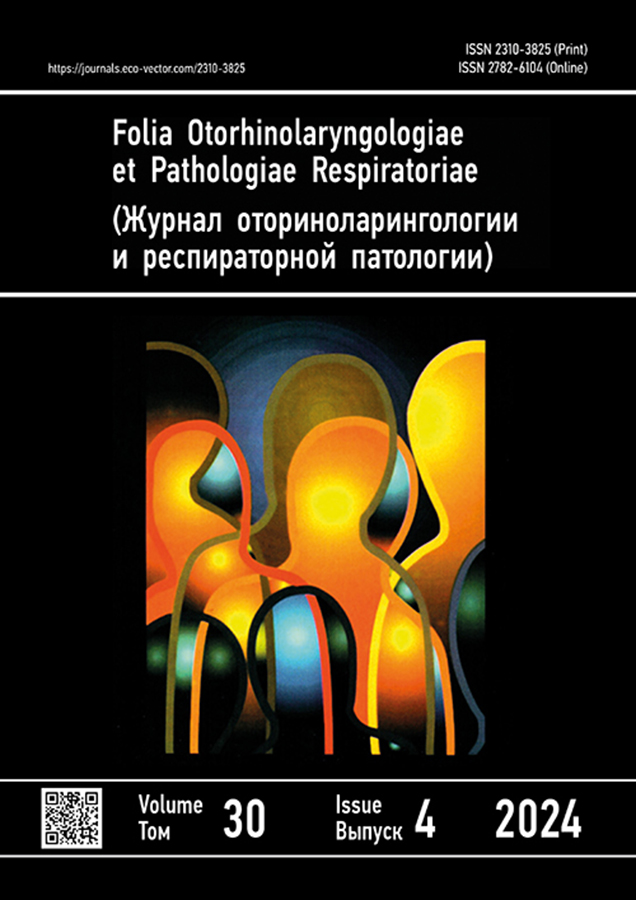Innovative instrument for natural sphenoid ostium enlargement
- 作者: Krasnozhen V.N.1,2, Pokrovskaya E.M.1,2, Valeeva D.R.3, Fedorova V.V.2,3
-
隶属关系:
- Russian Medical Academy of Continuous Professional Education
- Kazan Federal University
- Clinic “Family Health”
- 期: 卷 30, 编号 4 (2024)
- 页面: 310-315
- 栏目: Clinical otorhinolaryngology
- ##submission.dateSubmitted##: 19.12.2024
- URL: https://journals.eco-vector.com/2310-3825/article/view/643222
- DOI: https://doi.org/10.17816/fopr643222
- EDN: https://elibrary.ru/KJUKOK
- ID: 643222
如何引用文章
详细
Background: Advances in the surgical treatment of chronic sphenoiditis are not possible without the development of specialized instruments for manipulation in the sphenoethmoidal recess. The creation and clinical implementation of innovative tools for sphenoidotomy remain a relevant objective in modern rhinologic surgery.
Aim: To present the outcomes of using an innovative instrument designed for the enlargement of the natural sphenoid sinus ostium.
Methods: The instrument was developed by the Departments of Otorhinolaryngology of the Russian Medical Academy of Continuous Professional Education (Kazan branch) and Kazan Federal University. The proposed device Forceps for opening and enlarging the sphenoid ostium with a pathological tissue removal function is engineered to account for the anatomy of the anterior sphenoid wall and enables minimally invasive medial partial resection of the natural ostium.
Results: In the first stage of this study, anatomical experiments were conducted on 12 sphenoid sinuses from 6 cadavers, using the forceps for opening and enlarging the sphenoid ostium. The second stage included surgical treatment of 11 patients with isolated sphenoiditis. The performed resection created favorable conditions for reparative regeneration of tissue from the intact regions of the natural ostium, thereby preventing stenosis or fibrotic obliteration.
Conclusion: Clinical use of the Forceps for opening and enlarging the sphenoid ostium with a pathological tissue removal function demonstrated an absence of complications such as stenosis or fibrotic obliteration of the sphenoid ostium.
全文:
作者简介
Vladimir Krasnozhen
Russian Medical Academy of Continuous Professional Education; Kazan Federal University
Email: vn_krasnozhon@mail.ru
ORCID iD: 0000-0002-1564-7726
SPIN 代码: 4020-8920
MD, Dr. Sci. (Medicine)
俄罗斯联邦, Kazan; KazanElena Pokrovskaya
Russian Medical Academy of Continuous Professional Education; Kazan Federal University
编辑信件的主要联系方式.
Email: epokrunia@inbox.ru
ORCID iD: 0000-0001-9437-4895
SPIN 代码: 5051-9591
MD, Dr. Sci. (Medicine)
俄罗斯联邦, Kazan; KazanDiana Valeeva
Clinic “Family Health”
Email: diramilevna.dr@mail.ru
ORCID iD: 0000-0002-4835-9165
MD
俄罗斯联邦, KazanValentina Fedorova
Kazan Federal University; Clinic “Family Health”
Email: vella91@mail.ru
ORCID iD: 0009-0009-3546-6082
MD
俄罗斯联邦, Kazan; Kazan参考
- Wang ZM, Kanoh N, Dai CF, et al. Isolated sphenoid sinus disease: an analysis of 122 cases. Ann Otol Rhinol Laryngol. 2002;111(4):323–327. doi: 10.1177/000348940211100407
- Ruoppi P, Seppä J, Pukkila M et al. Isolated sphenoid sinus diseases: report of 39 cases. Arch Otolaryngol Head Neck Surg. 2000;126(6):777–781. doi: 10.1001/archotol.126.6.777
- Martin TJ, Smith TL, Smith MM et al. Evaluation and surgical management of isolated sphenoid sinus disease. Arch Otolaryngol Head Neck Surg. 2002;128(12):1413–1419. doi: 10.1001/archotol.128.12.1413
- Rothfield RE, de Vries EJ, Rueger RG. Isolated sphenoid sinus disease. Head Neck. 1991;13(3):208–212. doi: 10.1002/hed.2880130307
- Metson R, Gliklich RE. Endoscopic treatment of sphenoid sinusitis. Otolaryngol Head Neck Surg. 1996;114(6):736–744. doi: 10.1016/S0194-59989670095-5
- Sethi KS, Choudha S, Ganesan PK, et al. Sphenoid sinus anatomical variants and pathologies: pictorial essay. Neuroradiology. 2023;65(8):1187–1203. doi: 10.1007/s00234-023-03163-4 EDN: JHQMWF
- Larin RA, Krasilnikova SV, Shakhov AV, et al. Isolated lesions of the sphenoid sinus: features of diagnosis and treatment. Science & Innovations in Medicine. 2020;5(1):17–22. doi: 10.35693/2500-1388-2020-5-1-17-22 EDN: ZTLART
- Cheung DK, Martin GF, Rees J. Surgical approaches to the sphenoid sinus. J Otolaryngol. 1992;21(1):1–8.
- Kryukov AI, Klimenko KE, Tovmasyan AS et al. The method of instrumental dilatation of the anastomosis of the sphenoid sinus in the surgical treatment of chronic sphenoiditis. Russian Bulletin of Otorhinolaryngology. 2022;87(5):50–56. doi: 10.17116/otorino20228705150 EDN: VFXCWM
- Karpishchenko SA, Vereshchagina OE, Stancheva OA, et al. Surgical approach in the treatment of sphenoiditis. Folia Otorhinolaringologiae et Pathologiae Respiratoriae. 2016;22(3):47–50. EDN: WJJSFL
- Larin RA, Shakhov AV, Kuznetsov SS. Focal lesions ofsphenoid sinus in the practice of regional department of otorhinolaryngology. Russian Otorhinolaryngology. 2019;18(2):49–56. doi: 10.18692/1810-4800-2019-2-49-56 EDN: MCLIHC
- Messerklinger W. Technik und Möglichkeiten der Nasenendoskopie. HNO. 1972:20(5):133–135.
- Patent RU No. 230096/02.09.2024. Krasnozhen VN, Pokrovskaya EM, Valeeva DR, et al. Forceps for opening and expanding the sphenoid sinus with removal of pathological tissues.
补充文件














